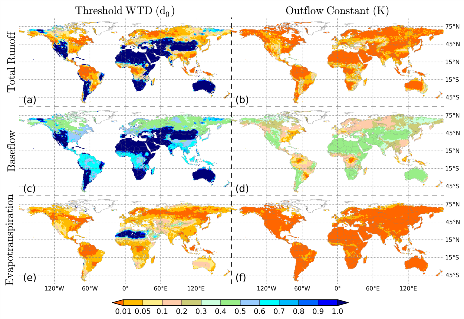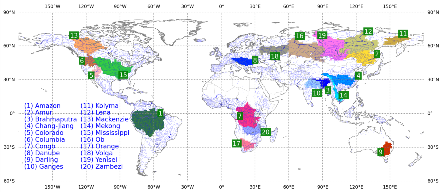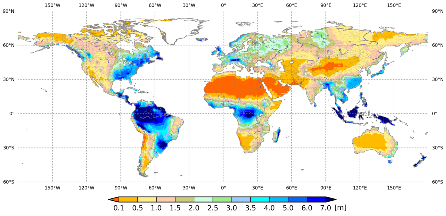The threshold WTD d0 , outflow constant K, and specific yield Sy are the main GW parameters (refer here for equations). The d0 (always taken as positive) represents a threshold depth to the water table shallower than which baseflow is generated. It is a function of climatic characteristics, topographical attributes, and geographical distribution of river networks in a basin. Large (deeper) d0 in general corresponds to humid regions where the regional WTD is mostly above stream level and hence baseflow is an important runoff generation mechanism. The rate of baseflow is controlled by the outflow constant (K), mainly a function of soil hydraulic properties and basin geomorphology (i.e., the connectivity of groundwater to streams). Smaller (larger) K suggests longer (shorter) GW residence time of the unconfined aquifer. The fluctuations of water table about the mean are also controlled by the specific yield (Sy) of the unconfined aquifer as a function of soil hydraulic properties.
Since, d0 and K are conceptual parameters, their sensitivities are analyzed in global scale.
Sensitivity Analysis in Global Scale:
|
 Fig. 1: The relative deviation from the mean of the simulations of (a) total runoff for different d0 (b) total runoff for different K, (c) baseflow for different d0, (d) baseflow for different K, (e) evapotranspiration for different d0 and (f) evapotranspiration for different K. |
|
Estimation of d0:
 Fig. 2: The 20 selected large river basins |
|
 Fig. 3: Global distribution of threshold water table depth (d0) in metres |
|
Estimation of K:
The tuning of K results in marginal improvement of river discharge simulations in the majority of selected river basins, suggesting that the sensitivity of hydrological fluxes to GW properties decreases as the spatial scale increases, which is consistent with the conclusions by Burtsaert (2008); Brutsaert and Sugita (2008).
Hence, global estimation scheme for K is deemed not necessary and not carried out.
References:
Brutsaert, W., 2008: Long-term groundwater storage trends estimated from streamflow records: climatic perspective. Water Resour. Res., 44 (W02409), doi: 10.1029/2007WR006518.
Brutsaert, W. and M. Sugita, 2008: Is Mongolia's groundwater increasing or decreasing? the case of Kherlen river basin. Hydrolog. Sci. J., 53 (6), doi:10.1623/hysj.53.6.1221.